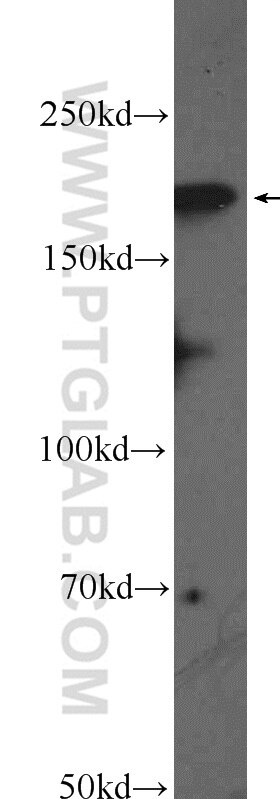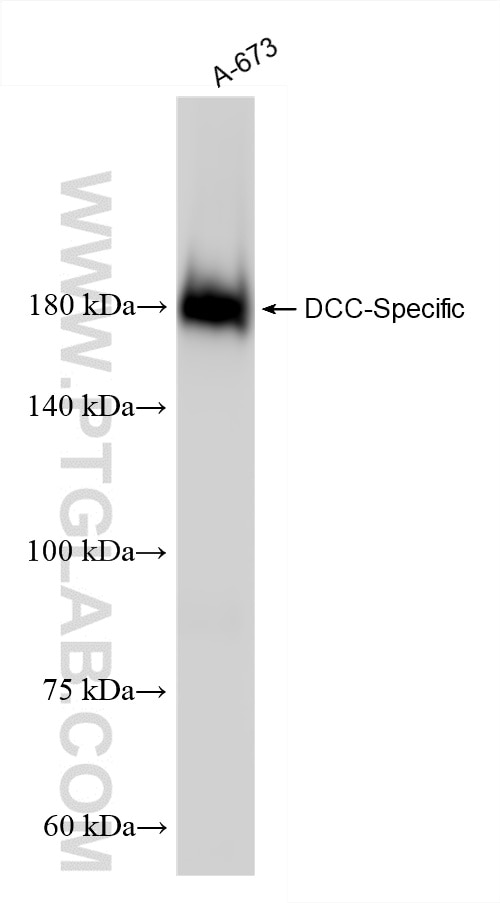Tested Applications
| Positive WB detected in | A-673 cells, mouse brain tissue |
Recommended dilution
| Application | Dilution |
|---|---|
| Western Blot (WB) | WB : 1:500-1:2000 |
| It is recommended that this reagent should be titrated in each testing system to obtain optimal results. | |
| Sample-dependent, Check data in validation data gallery. | |
Published Applications
| WB | See 2 publications below |
| IHC | See 1 publications below |
| IF | See 1 publications below |
Product Information
19123-1-AP targets DCC-Specific in WB, IHC, IF, ELISA applications and shows reactivity with human, mouse, rat samples.
| Tested Reactivity | human, mouse, rat |
| Cited Reactivity | mouse, rat |
| Host / Isotype | Rabbit / IgG |
| Class | Polyclonal |
| Type | Antibody |
| Immunogen | Peptide Predict reactive species |
| Full Name | deleted in colorectal carcinoma |
| Calculated Molecular Weight | 1447 aa, 158 kDa |
| Observed Molecular Weight | 180 kDa |
| GenBank Accession Number | NM_005215 |
| Gene Symbol | DCC |
| Gene ID (NCBI) | 1630 |
| RRID | AB_2878573 |
| Conjugate | Unconjugated |
| Form | Liquid |
| Purification Method | Antigen affinity purification |
| UNIPROT ID | P43146 |
| Storage Buffer | PBS with 0.02% sodium azide and 50% glycerol, pH 7.3. |
| Storage Conditions | Store at -20°C. Stable for one year after shipment. Aliquoting is unnecessary for -20oC storage. 20ul sizes contain 0.1% BSA. |
Background Information
DCC, also named as IGDCC1, belongs to the immunoglobulin superfamily and DCC family. DCC is a receptor for netrin required for axon guidance. DCC mediates axon attraction of neuronal growth cones in the developing nervous system upon ligand binding. Its association with UNC5 proteins may trigger signaling for axon repulsion. It also acts as a dependence receptor required for apoptosis induction when not associated with netrin ligand. DCC gene is a tumor suppressor gene. This antibody raised against a synthesized polypeptide of human DCC protein recognizes endogenous DCC with an apparent molecular weight of 180 kDa. As the predicted molecular mass of DCC is 158 kDa, the slower mobility is likely attributable to post-translational modification, perhaps by glycosylation at potential N-linked glycosylation sites (PMID: 7926722; 8044801).
Protocols
| Product Specific Protocols | |
|---|---|
| WB protocol for DCC-Specific antibody 19123-1-AP | Download protocol |
| Standard Protocols | |
|---|---|
| Click here to view our Standard Protocols |
Publications
| Species | Application | Title |
|---|---|---|
Sci Rep The expression of Netrin-1 in the MIA-induced osteoarthritic temporomandibular joint in mice. | ||
Front Pharmacol Cinnamaldehyde attenuates streptozocin-induced diabetic osteoporosis in a rat model by modulating netrin-1/DCC-UNC5B signal transduction |





